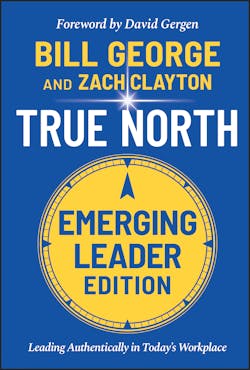Leading with Your Heart Is Key to Next-Gen Leaders
No more waiting. It’s time for current business leaders to move the next generation of leaders to their rightful place.
A bold statement perhaps, but Bill George, former CEO of Medtronic and currently professor of ethics at Harvard Business School, has studied leadership for a long time, and as he sees it, leadership values have changed. “The Baby Boomers’ style of leadership is often not in touch with the current needs of the workforce,” says George. “Employees’ core beliefs are different and the younger leaders that embrace those beliefs need to be moved up in the organization.”
George says this book is a call to emerging leaders of the next generation to discover their True North and follow their North Star. True North, as defined by George, is the moral compass that guides actions, and the North Star is the purpose that someone pursues to make a better world for everyone.
Operating from a sense of purpose with the goal of protecting others has always been the message from every safety professional I have ever come in contact with—it’s why they chose their profession. And the rest of the world took notice as safety leaders stepped up to create comprehensive plans and procedures to ensure the safety of everyone during the pandemic. This competency and empathy, which caught the attention of the C-suite, needs to continue to prevail at the top levels of the organization as it’s truly reflective of the future style of management.
Moving from 20th Century to 21st Century Leadership ValuesOne of the themes learned from the pandemic is that leadership needs to be authentic. The very use of that word is a credit to George, who wrote the classic book on the topic. “Authentic leadership needs to continue towards inclusivity at the center,” says George. “We need to move past identifying particular traits of people, such as gender, race, education and other labels, to understanding what people are passionate about and build a team that is bonded on that.”
In the book, George compares 20th-century leaders to 21st-century leaders. For example, while the organizational structure of 20th-century leaders was hierarchical management, the 21st century is characterized by an empowering leadership style. And that empowerment comes from talking to employees.
Another transition is that while 20th-century thinking caused leadership to value IQ, next-generation leaders value EQ, or emotional intelligence. “The good news is that unlike IQ, which doesn’t change as we age, EQ can be developed. In the book, I give the example of the CEO at Microsoft who turned the culture around using EQ. Companies can go from a know-it-all attitude to a learn-it-all attitude.”
The leaders of the 21st century, those who embody the values necessary for future success, need the opportunity to strut their stuff. “Don’t hold these leaders back,” implores George. “Move them into the key positions and watch how well they do.”
About the Author
Adrienne Selko
Senior Editor
Email [email protected]
Adrienne Selko is also the senior editor at Material Handling and Logistics and is a former editor of IndustryWeek.



